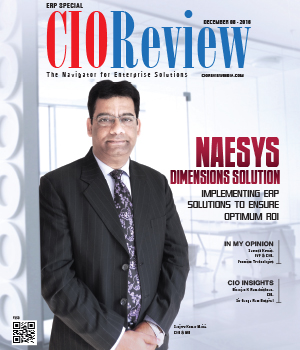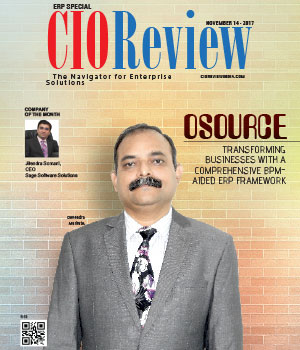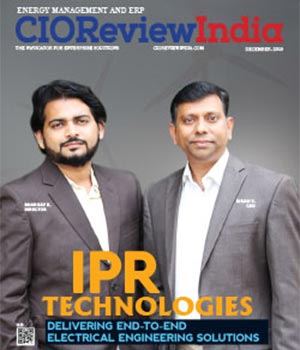ERP Systems Evolving to Improve Business Agility
Abhrasnata Das | Tuesday, 13 December 2022, 13:12 IST

Ashish Bansal, Sr. Principal, Global Products and Technology, GSK in an interaction with CIOTechOutlook, shares his views on the ERP domain. In the conversation he gives insights on change management, data migration, and more.
The global ERP market is expected to touch $112.3 billion by 2026. How is this industry developing in India? What are the key factors driving the growth?
The ERP software helps to manage various financial and manufacturing activities like accounting, cash flow, supply chain, logistics and traceability. The market is anticipated to grow during the forecast period because of increased access to ERP functionalities via smartphone applications and surge in adoption of cloud, rise in need of operational efficiency and transparency in business processes and increase in demand for data-driven decision making. The increasing adoption of innovative and advancing SaaS technologies, broadening the value of existing ERP systems, minimizing third-party dependencies, more highly secured resources, advancing financial systems, and other notable factors are driving up the growth in demand for ERP software.
An ERP implementation involves more than just switching to a new software system. It typically means overhauling business processes to take advantage of the efficiency and productivity improvements possible with the new solution. How can efficient change management be attained?
The ERP project will not only result in system changes, but process and organizational changes too. A dedicated team with workstream focus on change is a requirement for the organization to deal with the volume of the impact/change. It is must that the whole process is transparent and resilient.
Some of the non-exhaustive key aspects for efficient change management to be attained are:
- Continue to reinforce the defined business case/ERP strategy which shows the changes to processes and system functionality, including the benefits brought about with the changes; share the business case with pertinent individuals within the organization.
- Consider hiring a third party to perform an organization readiness assessment towards people, process, technology and culture aspects. Also, to define a blueprint and roadmap with Org architect inline to the business strategy and expectations keeping in mind other critical business and technology milestone being performed in parallel.
- To develop and maintain consistently good communication between the project team and the organization as a whole, using mediums such as internal sites (SharePoint, MS Teams, Workplace etc.), newsletters, focused mailers, workshops, lunch and learns to assist in delivering the strategy, roadmap and support which would be expected.
- Key users should be involved with the project and its progress, as this will aid in testing and acceptance of the changes.
- Be prepared to periodically train the staff and key stakeholders during the project and even after post go‐live dates. Also, don’t put the guards down post go-live as hyper-care support and process stability would be equally important for the overall project success.
ERP implementations entail multiple phases that include discovery and planning, design, development, data migration, testing, and deployment. Each phase brings critical tasks, and all elements need to stay on track. How should the planning be conducted while implementing ERP?
Planning includes researching and selecting a system/provider/implementer, setting up a project team and defining detailed system requirements. The project team will handle a broad range of roles related to the implementation, including laying out the project plan and target dates, ensuring adequate resources are allocated, making product and design decisions, and day-to-day project management. The ERP project team typically includes an executive sponsor, a project manager and representatives from the departments that will use the system. Involving senior management is critical to ensure the project gets the resources it needs and to provide the backing needed to implement change across the organization.
The team also may hire an external consultant or ERP implementation partner to provide expertise in designing and configuring the system. It should also include any internal specialists involved in implementing the system, such as a representative from IT and a report writer who will develop customized reports for users across the organization. One of the team’s early goals will be to develop a detailed understanding of current issues, including process inefficiencies and requirements for the ERP system. If the organization has previously developed an ERP business case, it may have already defined broad business issues and goals for the implementation, which may include a faster financial close, improved insight into operations.
These can be used to direct more detailed analysis, including documentation of existing workflows, and to focus development of the system. The team may select and acquire an ERP system during this phase, as the organization develops a clear idea of its requirements. One major decision is whether to use an ERP system that runs on-premises or in the cloud. For an on-premises system, you buy and install hardware and software in your organization’s data center. In contrast, cloud-based ERP is generally provided as a subscription service accessed via the internet, so it can be faster to implement and may require fewer in-house IT skills.
Data migration is often the most challenging task in ERP implementation. In a large organization, the information may be spread far and wide across the organization, buried in accounting systems, department-specific applications, spreadsheets, and perhaps on paper. How can effective data migration be attained?
Some data can be migrated ahead of deployment, while other information—such as current transactions—should be migrated immediately before going live. Some organizations aim to deploy all the modules of the ERP system concurrently, while others focus first on specific high-priority modules or processes and add others later in stages. To minimize risk, some organizations also continue to run older systems in parallel with the new ERP implementation for a time, although this can add to the overall project cost and reduce user productivity. Organizations sometimes make the mistake of simply migrating all historical data to the new system. In reality, some of the information in older systems may be obsolete or unnecessary. Is 10-year-old order information really valuable? Does every supplier in your list still exist or active? The transition to an ERP system is an opportunity to clean up and rationalize the organization’s data, and it’s worth creating a clear plan for doing so. It makes sense to comb through legacy data carefully, weeding out old customer accounts and looking for data inaccuracies.
ERP implementation is not a one-off effort that ends when the new system goes live. The solution must continue to evolve to support new business demands and technology. How can the ERP system be advanced without hampering business conduct?
This is what you’ve been striving toward: the day the system goes live. Be prepared for potential issues, since there may be a lot of moving parts and possibly some befuddled employees, despite your best efforts to prepare them for the change. The project team should be readily available to answer questions, help users understand the system and attempt to fix any issues. Your implementation partner should be able to help with troubleshooting if necessary. It may take time for users to adapt to the system, tweaking’s required and achieve the anticipated productivity gains.
How do you see the ERP domain evolving in the near future?
In the current disruptive market environment, with technology evolving at breakneck speed, the business processes are increasing and so is its complexity. The integration of ERP systems can help businesses become more agile and easily adapt to the constant changes. It is equally important to keep updating the system to ensure you’re up-to-date with the latest trends.
The best part about ERP systems is, its effective planning and strategy which enhances the efficiency of the business and ensure it sails smoothly. Some of the key technology trends to keep an eye on are journey to cloud deployment, integration with Internet of Things (IoT) with surge in data and analytics, Mobile ERP and its security, rage for Artificial Intelligence (AI), industry-specific ERP adoption and changes and staying flexible during the pandemic situations while avoiding over personalization by customizing it too much.
CIO Viewpoint
ERP Systems Evolving to Improve Business Agility
By Abhrasnata Das
Transforming Manufacturing by Creating a...
By Thiagarajan N, Director IT at IMI Critical Engineering
How Reliance Entertainment leverages SMAC and...
By Sayed Peerzade, Group CIO, Reliance Big Entertainment & Reliance Entertainment - Digital
CXO Insights
Hit Reset with Technology as the Trusted Advisor
By Guruprasad Gaonkar, APAC SaaS Leader - Office of Finance (ERP) & Digital Supply Chain, Oracle
ERP Implementation: The Pitfalls to Avoid
By By Navjot Singh Sidana, General Manager – ERP, Delhi Integrated Multi-Modal Transit System (DIMTS) Ltd.
Power And Water Nexus Central To Data Center...




.jpg)





